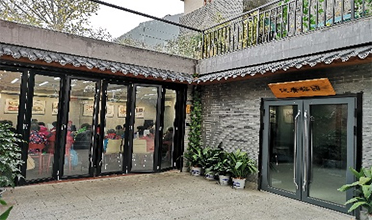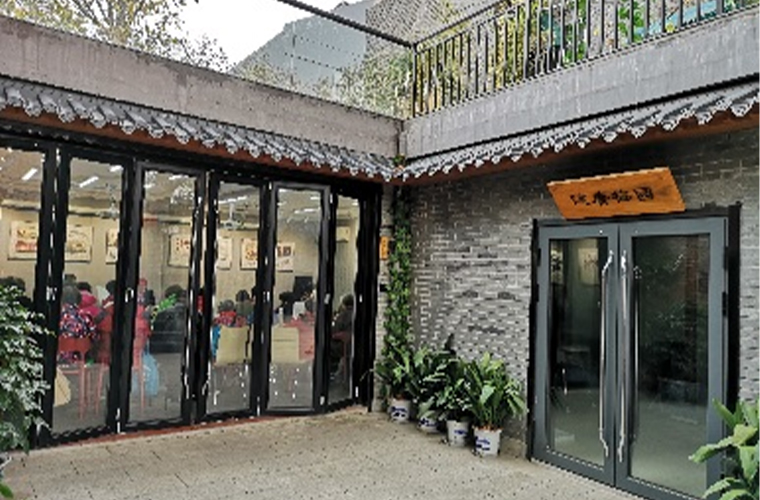



05 Existing problems in current practice
Through field interviews with community residents, the problems concerned by residents can be concluded into the following four aspects:
(1)Residential buildings
In Meiyuan New Village community, the quality of residential buildings hiding inside the block is poor with damaged walls, lacking daily repairment and maintenance.
(2) Street space
The streets and lanes in the residential area that not the main tour route are seriously teared, and muddy in rainy days with the car parking and the stacking of garbage and sundries are out of order, which affects the overall landscape style and traffic efficiency of the streets and lanes, and existing certain security risks;
(3) Public communication space
The residents of Dongjiandao Community have high desire for communication. However, there is a lack of public space in the community, so residents can only move tables and chairs temporarily outside with poor activities, especially the elderly-oriented facilities and entertainment spaces are insufficient.
(4) Parking spaces
Generally, there are no parking spaces for motor vehicles in residential areas, leading car parking along the road, which hinders normal car passing by.
06 Improvement strategies and suggestions
6.1 Systems and policies
6.1.1 Coordinating among departments and formulate management rules.
Before regenerating and adjusting the community spaces, combining the requirements of space development and space environment quality in urban historical protection planning and community planning. Making clear the bottom line of community space regenerating to avoid irreversible damage to historical space caused by planning mistakes. This requires information sharing and department coordination, which will jointly promote the work of community regeneration. In addition, professional departments should pay attention to reserving space for the flexible development of communities when formulating management technical rules.
6.1.2 Making clear building property rights and implement classified management
The property rights of community buildings in historical areas should be carefully treated, and the government and street management units should conduct a comprehensive investigation on the building ownership of the reconstructed spaces, and classify it according to the property rights, public and private property, and establish a basic information data base. In the process of regeneration, connecting the corresponding ownership and responsible stakeholders through data effectively. For buildings with many left over problems, stressing public participation, and appropriate financial subsidies or policy incentives should be given during the regeneration process to achieve a win-win effect.
6.1.3 Encourage the access of market capital and provide appropriate policy incentives.
For external market capital such as investors who participate in the regeneration of historical sites, appropriate preferential policies and rewards can be given according to their contributions to the community development in the area, such as floor area ratio awards and the limitation of building development service life, so as to promote the economic feedback and drive of developers to community residents, form good social relations, strengthen the connection between communities and external capital, and further increase the accumulation of social capital in communities.
6.1.4 Improve the "community planner system" to boost community development
At present, communities lack the "community planner" mechanism. With the increasing attention paid by the society to the community's own development, the planner's "community responsibility system" needs to be constantly improved. As a professional stakeholder, community planner can promote the community development and autonomy, and connect different parties. As a planner, helping community managements to organize residents and build communities from a professional perspective is needed, so as to deepen the effective interaction among residents, managers, and external social capital.
6.2 Subject and Actions
The government should appropriately decentralize, promote diversified social capital to participate in the regeneration process, clarify the roles and functions of each subject in the main stage of the regeneration projects, give full play to market advantages and make full use of local resources, which not only reduces the financial burden of the government, but also conforms to the vital interests of residents.
07 Conclusion
Micro-regeneration of community is a long-term project, and it is usually problem-oriented. Therefore, the task can be decomposed in stages according to the current demands, and the spatial quality can be gradually improved by gradual organic regeneration. Community space is in the process of dynamic change, and also existing a high mobility of community residents, so the unchanged planning is difficult to ensure that it can meet the space needs of residents at all stages. The community needs a long-term dynamic mechanism of self-regeneration or long-term "companion" social support to achieve high-quality long-term development. Therefore, it is particularly important to cultivate the endogenous self-organizing power in the community, which requires community residents and managers to gradually form an effective maintenance of community space in the long-term grinding-in, rely on the remodeling of community emotional identity, mobilize the enthusiasm of community residents to participate in public affairs, creating a applicable system for public participation, and provide residents with a platform and opportunity to express their thoughts.
Author: Qian Yufei, Southeast University Architecture College
Source:<https://mp.weixin.qq.com/s/oCI1OG62xcqQj1XDoVE11g>
Edited and Translated by Zhang Chenxi